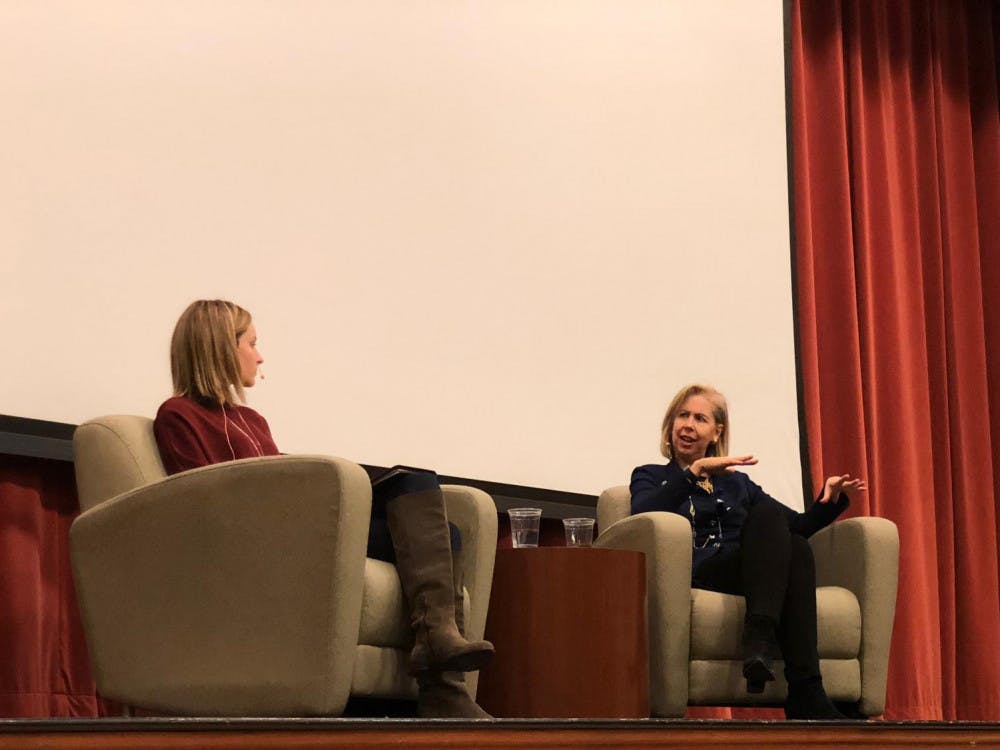The Middlebury Women Leaders group launched their first ever Middlebury Women’s Leadership Symposium this past week with the goal of empowering women and providing an open forum to discuss women’s issues. Club President Erin Van Gessel ’17.5 said that the “impetus for the symposium was to commemorate the Women’s March from 2017 and keep the momentum around women’s empowerment going into 2018.”
On Friday, keynote speaker Nancy Gibbs sat down with Van Gessel in Wilson Hall to discuss her career in journalism and offer advice to students.
An accomplished writer, leader, author and student, Gibbs makes for a powerful role model. As the first female editor-in-chief of TIME magazine, she led the transition from print magazine to digital media company, introduced the Firsts project and made way for TIME magazine to become the biggest news media brand on Instagram. Before beginning her illustrious career at TIME, Gibbs graduated from Yale summa cum laude with honors in history. She also holds a degree in politics and philosophy from Oxford, where she was a Marshall Scholar. She is, as Gessel said, “a fantastic role model for women at Middlebury who want to seek out challenging careers after college.”
Gessel began the discussion by asking if Gibbs had always dreamt of being editor-in-chief. On the contrary, Gibbs told the audience that her ultimate goal had always been to be a writer, as writing “would give you a front-row seat on the most interesting people, the most interesting stories.” This proved to be true for Gibbs. After being hired by TIME as a fact checker in 1985, she was eventually promoted to a writer’s position where, she said, “the view was every bit as fascinating as I had hoped.” In her 32-year career at TIME, Gibbs spent 25 of those years writing, eventually gaining the nickname “Babe Ruth” for logging a mountainous number of cover stories – 175 to be exact – more than any other writer in the history of the magazine.
Gibbs admitted that she had no managerial background or prior experience handling budgets when the time came for her to step into the shoes of editor-in-chief. However, as TIME was undergoing a transition period, she knew it was time to “get the hell out of [my] comfort zone” and tackle the job.
The conversation then turned to the topic of women leaders. When she took the job as lead editor in 2013, Gibbs felt “so accustomed to seeing women in leadership positions” that she felt no obligation to be a role model to women. The glass ceiling, she felt, had already been broken. To her surprise, she received an outpouring of support from women who saw her promotion as a symbol of progress.
Gibb said she owed part of her comfort in taking on the leadership position to her parents, who always told her she could do anything. “If you’re interested in something, do it; if there’s a door closed, bang on it,” she said. This is a message she has passed onto her own daughters as well. While she felt that the importance of her being the first female editor-in-chief was not her gender but the experience she had to offer, Gibbs embraced the role, using her position to fight for equal pay and to highlight extraordinary women.
One of the first things Gibbs did as editor was assess the salaries of women to make sure they were equivalent to men working the same job. “[There were] all kinds of inequities in compensation that I didn’t think necessarily made sense,” she said. Something that became glaringly obvious was the fact that the men on her staff were far more likely to ask for a promotion than the women were. She also noted an unfortunate penalty for loyalty that affected both men and women. “If you come in and do well and are constantly promoted, you still may not be paid as well as someone who is brought in from the outside to do the same job,” she said.
In 2017, under Gibbs’ leadership, TIME launched the Firsts project, celebrating powerful women such as Oprah, Madeleine Albright and Aretha Franklin – all trailblazers in their fields. The idea, Gibbs said, came from watching “glass ceilings being broken and wanting to look at what that experience is like.” The women – artists, athletes, TV hosts, diplomats and more – span a diverse range of careers but comprise a collective array of powerful role models.
During the Q&A session, Gibbs discussed the relationship between President Trump and the press, framing it within the context of previous presidencies. “I haven’t met a lot of politicians who are in love with my profession,” she said, to the laughter of the audience. The difference now, she discussed, is the widening gap between parties in considering whether the press’ enduring role should be that of a watchdog. In any case, Gibbs said that despite the President’s rather tempestuous relationship with journalists, she has “not seen it in any way” stop reporters from doing their job.
Gibbs ended by discussing her guiding principles as a leader and offering advice to the students in the room. As a leader, she advised, “surround yourself with people who are better, and smarter, and more talented than you are. And then you will succeed.” “Recognize that you can’t do everything,” she added, and empower those who can do what you need them to. To students, she recommended “talk[ing] to as many people as you can” before going into any field.
Alongside Nancy Gibbs’ visit, the symposium included a conflict mediation workshop led by President Patton, a “Lean In” conversation about women in the workforce, a discussion on feminism with local Nulhegan Abenaki Native American women and a fashion-show fundraiser for She Should Run, a nonpartisan nonprofit that helps women run for political offices.



